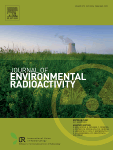
Publication date: October 2017
Source:Journal of Environmental Radioactivity, Volume 177
Author(s): Isadora Aumond Kuhn, Ari Roisenberg
The Rio dos Sinos Watershed area is located at the Middle-West region of the Rio Grande do Sul State, Southern Brazil, along thirty two municipalities and affecting 1.5 million inhabitants and many important industrial centers. Three main aquifers are recognized in the study area: the unconfined-fractured Serra Geral Aquifer System, the porous Guarani Aquifer System, and the Permian Aquitard. This study aims to understand groundwater, surface water and human activity interactions in the Rio dos Sinos Watershed, evaluating the application of stable lead isotopic ratios analyzed for this propose. Thirty six groundwater samples, 8 surface water samples and 5 liquid effluents of tanneries and landfills samples were measured using a Thermal Ionization Mass Spectrometer Thermo-Finnigan and a Neptune Multi-Collector Inductively Coupled Plasma Mass Spectrometer. Groundwater isotopic ratios have a wider range compared to the surface water, with less radiogenic averages
208Pb/
204Pb = 38.1837 vs 38.4050 (standard deviation = 0.2921 vs 0.1343) and
206Pb/
204Pb = 18.2947 vs 18.4766 (standard deviation = 0.2215 vs 0.1059), respectively. Industrial liquid effluents (tanneries and industrial landfill) have averages
208Pb/
204Pb = 38.1956 and
206Pb/
204Pb = 18.3169, distinct from effluent samples of domestic sanitary landfill (averages
208Pb/
204Pb = 38.2353 and
206Pb/
204Pb = 18.6607). Hierarchical cluster analysis led to distinguish six groups of groundwater, representing the three aquifers that occur in the area, two clusters suggesting groundwater mixtures and one demonstrating a highly contaminated groundwater. By analyzing the cluster results and wells' stratigraphic profiles it was possible to distinguish the different aquifers in the area. The Serra Geral Aquifer System has
206Pb/
204Pb ratios between 18.4718 and 18.7089;
207Pb/
204Pb between 15.6692 and 15.6777;
208Pb/
204Pb between 38.6826 and 38.7616;
207Pb/
206Pb between 0.8372 and 0.8623;
208Pb/
206Pb between 2.0671 and 2.0964 and the Guarani Aquifer System has a wider range (
208Pb/
204Pb ranged from 37.9393 to 38.1279 and
206Pb/
204Pb ranged from 18.0892 to 18.3217). Water mixing of these two aquifer systems is reflected by transitional results. The results confirm that the hierarchical cluster analysis of lead isotopes is a useful tool to discriminate different aquifer conditions, reflecting mostly the influence of the natural lead isotopic composition of the aquifers instead of the anthropogenic activities (urban and industrial), except when the groundwater is highly contaminated by human activity.
http://ift.tt/2rd8OHw